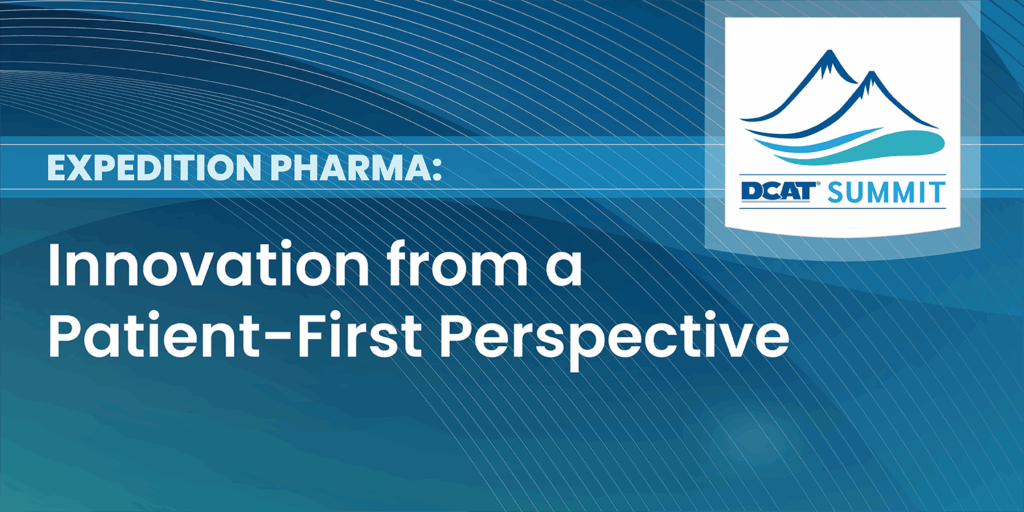The DCAT Summit at Lugano Recap: Trade, Global Manufacturing, Sustainability & AI Through a Patient’s Lens

The DCAT Summit at Lugano, “Expedition Pharma: Innovation from a Patient-First Perspective,” held June 4–5, 2025, in Lugano, Switzerland, concluded with a thought-provoking panel discussion that examined macro issues impacting the industry today—tariff/trade policy, geographic dispersion of pharmaceutical manufacturing, sustainability, and digitalization—all considered through the lens of what is central to the industry: the patient.
Leading the panel discussion was Michael Semo, Associate Vice President, External Sourcing at Eli Lilly and Company, and DCAT Board Member. He was joined by Pierfrancesco Morosini, President and Chief Executive Officer of Icrom, an Italian CDMO of active pharmaceutical ingredients (API) and a DCAT Board Member; Jim Fries, CEO of Rx-360, an industry consortium of pharma manufacturers and suppliers focused on supply chain integrity; Christian Jones, Chief Commercial Officer of Nanoform, a CDMO specializing in high-drug-load nanoformulation technologies; and Justin Schroeder, Vice President, Global Technical Services at PCI Pharma Services, a CDMO of drug products and contract packaging services.
Tariffs/trade & onshoring/reshoring to the US
Top of mind for the industry is evolving US tariff/trade policy and how it may affect bio/pharmaceutical supply chains, costs, and potentially access to medicines. Part of the impetus for the imposition of tariffs by the US government is to increase US competitiveness in manufacturing and to incentivize the reshoring or onshoring of production to the US.
Broader points discussed by the panel were that given the complexity of bio/pharmaceutical supply chains and the time and costs to re-configure such supply chains, shifts in global bio/pharmaceutical manufacturing are not necessarily easily achieved. In addition, panelists noted that onshoring/reshoring and supply-chain shifts may result in unintended consequences, such as shortages of certain drugs or higher costs, which may be passed through to the consumer, with both potentially impeding patient access to medicines.
The EU and the Critical Medicines Act
Although much attention has been focused on the US and its tariffs/trade policy, the European Union (EU) is also advancing policy to encourage domestic bio/pharmaceutical manufacturing to migrate production of critical medicines from non-EU sources as a way to mitigate drug shortages. Drug shortages are not a new issue per se, but were further exacerbated during the pandemic, which exposed supply-chain vulnerabilities and a reliance by the EU on non-EU sources for pharmaceuticals and pharmaceutical ingredients, particularly in the generics industry.
To address the industrial challenges behind shortages of critical medicines, the Critical Medicines Alliance, consisting of stakeholders from industry, health organizations, civil society, and EU member states, was set up and launched in April 2024 to identify key challenges and formulate recommendations and priorities for action, propose solutions to strengthen the supply of critical medicines in the EU, and advise on the development of dedicated industrial policy focusing on critical medicines. The outgrowth of these efforts is the Critical Medicines Act, which was proposed by the European Commission in March (March 2025), and which is now under EU legislative review and discussion. The Critical Medicines Act seeks to improve the availability, supply, and production of critical medicines within the EU.
Icrom’s Morosini offered an assessment of the Critical Medicines Act. He readily acknowledged the value of reshoring production of APIs for critical medicines to the EU, but also pointed to some key gaps: a lack of dedicated government funding for manufacturers for needed capital expenditures for technologies and capacity to support reshoring and practical ways to address higher operating costs in Europe.
He also noted that the challenge of supply and costs relates not only to the API, but also to key regulatory starting materials, which are often sourced outside the EU. “If you don’t secure also the supply of the starting materials and the excipients, you are back to the square zero problem,” he said. True resilience, he suggested, requires cross-border collaboration, including with countries the EU is trying to decouple from.
Finally, Morosini highlighted the importance of a regulatory fast track at the EU level for the approval of new production units and processes dedicated to the manufacturing of critical ingredients.
Nanoform’s Jones said that addressing the cost differential will require innovation. “If we really do need to move manufacturing back to Europe or the United States, we have to develop innovations that enable efficiency,” he said. “It’s the only way that we’ll be able to do it and not pass that cost to the patient.”
Sustainability: a real commitment
Sustainability was also an important part of the panel’s dialogue. PCI Pharma’s Schroeder noted the advancement of sustainability goals and science-based metrics and alignment among bio/pharma companies and their suppliers. “The industry has begun to coalesce on some standards, which has really moved the needle pretty dramatically,” he said. Jones added that some newer technologies—initially designed for drug product performance improvements—have turned out to offer environmental benefits as well.
Digitalization & AI
When asked about artificial intelligence (AI), most panelists responded with cautious optimism. For API manufacturing, Icrom’s Morosini explained, there is now a greater emphasis on increased automation and analytics. The focus on AI is more limited for now—but that may change. For example, his team is launching a project to train machine-learning models to optimize chemical reactions, using data from the literature combined with historical batch records.
Rx-360’s CEO Fries emphasized the value of using AI to extract value from internal data. “If we can take our own data and start aggregating and analyzing it, we can gain a lot of efficiencies,” he said. “That’s a home run.”
Collaboration is key
As the session closed, panelists reflected on what collaboration really means, emphasizing the importance of interdependence, trust, and partnership among bio/pharma companies, suppliers, and the industry as a whole to address the overarching challenges the industry faces.
Rx-360’s Fries brought the topic back to the individual level. “Events like this one today [the DCAT Summit at Lugano] aren’t just about companies networking,” he said. “They’re about peers sharing ideas and walking away with something that makes us better.”
That sentiment echoed across the panel: Value creation depends not on grand solutions, but on daily discipline, shared goals, and ongoing dialogue.
Note: This is the final article in an article series providing key highlights and insights from the DCAT Summit at Lugano: Expedition Pharma: Innovation from a Patient-First Perspective, which was held June 4–5, 2025, in Lugano, Switzerland.
See below for other articles:
Part I, Driving Value through Patient-Centricity in Drug Development and the Supply Chain
Part II, Innovation at the Foundation of Pharmaceutical Development & Manufacturing
Part III, Serving Patients through Agility and Innovation in Development and Manufacturing
Part IV, Innovating Formulation Development & Drug Delivery for Improving Patient Outcomes


